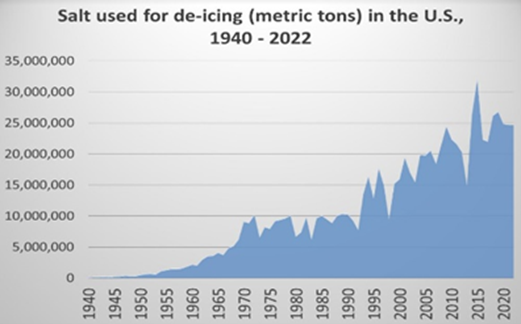Salt pollution in our streams begins with the salt that is spread on roads and parking lots in the winter
Salt Pollution in Our Streams
What happens to all that salt they put on the roads and parking lots in the winter? It just gets washed away by the next rainstorm. Right? Well actually, no. We are becoming more and more aware that excessive use of road salt is having major environmental impacts on streams and aquifers in our region.
Why is this a problem? After road salt is applied, subsequent rain events wash some of it directly into streams as runoff. This causes large temporary spikes of salt levels as much of the salt washes downstream. The remaining salt gets washed onto the ground and then is transported down into the aquifers below.
Salty ground water is a problem for the streams in our area because they are “gaining” streams. This means that they are fed year-round, primarily by the groundwater (see image). Rain events also supply streams with water, but these only lead to temporary increases in stream level.
Gaining Stream Image taken from https://books.gw-project.org/groundwater-in-our-water-cycle/chapter/groundwater-connection-with-streams/
Salt Usage is Increasing - Bad News for Streams
Statistics show that the amount of salt being applied has risen exponentially over the past few decades. This is driven in part by increased development, resulting in more roads and parking lots that need de-icing. It is also caused by changing expectations about how much salt should be used and concerns over liability for slips and falls. All these factors result in excessive use of salt products, above what is necessary to efficiently clear ice.
Graph courtesy of Stroud Water Research Center and Carey Institute of Ecosystem Studies. Data from USGS
LLWS Project to Measure Summer Salt Concentrations in our Streams
In 2023, LLWS became aware of excessive salt use and decided to monitor the long-term effects of salt in the Little Lehigh watershed. We conducted a “Salt Snapshot” event in August 2023. In one day we tested water from 45 sites throughout our watershed. The sampling took place in a three-hour period, when the streams were at base (low) flow. Summer sampling shows us how much salt is present year-round, because it is done at a time when the streams are only fed from groundwater aquifers.
We tested the samples for chloride and conductivity levels. What we found were levels of chloride above 50 milligrams per liter (mg/l) in 15 of the sampling sites. Locations with higher chloride levels were mainly sites in more developed areas of the watershed. Deicing products, even those labelled “safe” contain chlorides (sodium chloride (salt), magnesium chloride, etc.)
Below is link to map of the LLWS August sampling sites. Click on each site to see chloride and conductivity levels:
https://padlet.com/latzgoj/salt-snapshot-locations-98sm31sxgb1kzx6q
Summer, low flow, Chloride Levels in Little Lehigh Creek and Tributaries, 2024
The map on the right shows chloride concentrations (mg/L) in Little Lehigh Creek water as of August. Lehigh County, PA, is outlined in black. Chloride levels exceeding 30 mg/L typically indicate creeks affected year-round by winter salting. Levels above 50 mg/L are detrimental to sensitive aquatic organisms, which form the base of the creek's food web. Chloride concentrations ranged from 0 mg/L near Blue Mountain to 254 mg/L in Allentown on Trout Creek.
While levels vary, there is a noticeable trend of higher chloride concentrations with increased land development.
Measured chloride levels above 50 mg/liter are a problem. Exposure to chloride at these levels has been found by scientists to cause harm to aquatic life, including fish, amphibians, and invertebrates. These organisms are sensitive to changes in water chemistry, and elevated chloride levels can cause stress and stunted development at low levels and even lead to mortality in severe cases. Year-round exposure to the chloride from salting, even at quite low levels, can harm the biodiversity of our ecosystem.
There are also major concerns about the long-term effects of salt accumulation on our groundwater. Many people in our area depend on the aquifers for drinking water. People who are on very low sodium diets should not drink water with more than 20 mg/l of sodium according to the Environmental Protection Agency (EPA). Pollution of groundwater creates a huge problem for future generations. Once aquifers are contaminated with salt, it is impossible to clean them up, and desalination of drinking water is very costly.
Salt causes corrosion and infrastructure damage to metal structures. The EPA has estimated that road salt usage has cost us approximately $5 billion dollars in annual repairs to cars, trucks, roads, and bridges.
What Can You Do?
First of all, be aware of the quantity of salt that you apply to your driveway and sidewalks in wintertime. You can reduce the amount you need by shoveling regularly. When you apply the salt, use about 12 ounces for a 20-foot driveway, or 10 sidewalk paving squares. Sweep up any leftover salt.
If you would like to volunteer with our group for future salt sampling projects, click the button below.
To find out more, CLICK BELOW to explore other Salt Resources.
Carey Institute of Ecosystem Studies – Road Salt: The problem, the Solution, and How to Get There
https://www.caryinstitute.org/sites/default/files/downloads/report_road_salt.pdf
Video: Salt Impacts on Water Quality – John Jackson, Stroud Water Research Center
https://www.youtube.com/watch?v=Of4hpuFzgn0
Izaak Walton League of America Salt Watch – What you can do to Take Action
https://iwla.org/take-action-to-reduce-chloride-pollution/
Trout Unlimited Valley Forge salt pollution webpage
https://www.valleyforgetu.org/resources/whitepapers/road-salt/




